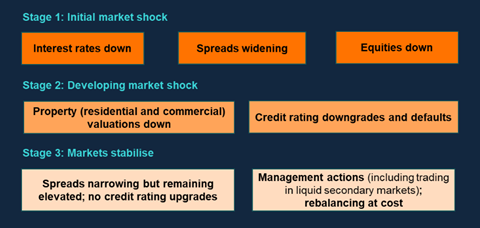Leading bulk annuity providers have been given a clean bill of health from the Bank of England following a major stress test of their balance sheets. Pensions Expert takes a look at what the results mean for schemes exploring a buy-in or buyout.
The Bank of England’s Life Insurance Stress Test (LIST), the results of which were published this week, make for positive reading. All eleven insurers that were put through their paces demonstrated resilience through a “severe financial market stress scenario”.
There has been significant activity in the bulk annuity market over the past few years – and this is expected to continue, with LCP predicting £350bn to £550bn of assets transferring from defined benefit pension schemes to insurers over the next 10 years.
As such, this major exercise has been keenly anticipated by many in the sector. It is the first conducted under the new Solvency UK regulatory regime, introduced last year.
“These results will be of most interest to schemes considering insurance, but for schemes that aren’t, they provide some insight into the level of resilience needed to offer benefit security comparable to that achieved by insurance.”
Sam Matto-Willey, Aon
The LIST 2025 analysis scrutinised insurance company balance sheets as of 31 December 2024. Portfolios were subjected to a “core” scenario in which risk-free interest rates fell, equity and property markets declined, and bond spreads widened, leading to increased company defaults and rating downgrades. They were also tested in two “exploratory” scenarios.
In the core scenario, the Bank of England found that the aggregate solvency coverage ratio fell from 185% to 154%, with the aggregate surplus above regulatory capital requirements falling from £30.5bn to £21.9bn.
“Owing to their strong starting capital position… insurers have sufficient resources to withstand the shocks of this severe but plausible scenario,” the Bank said in its report. “All participating firms continue to meet their regulatory capital requirements at each stage of the financial market stress.”

‘A reassuring picture of resilience’

Ian Aley, head of pension transactions at WTW, said the stress test’s positive results were reassuring for those considering a bulk annuity. However, he added that next week’s publication of firm-specific reports would “provide further insights to schemes with an interest in this market”.
“We anticipate that pension schemes will seek further diligence in this area, such as asking for, and considering, alternative sensitivities,” Aley continued. “Financial strength is one of many factors considered by trustees and sponsors when selecting an insurer. Others, in particular the impact of insurance on the member experience, will also inform this decision.”

James Silber, partner at LCP, said the results “show a reassuring picture of resilience across the bulk annuity insurers, even under severe financial stress”, which should give trustees and sponsors confidence in the insurance sector’s financial strength as well as “additional comfort over the security of insured member benefits”.
The firm-level results will be important, Silber added, as “differences in asset mix, capital strategy, and use of reinsurance can have a big impact” on insurers’ risk profiles.
Sam Matto-Willey, head of insurer due diligence at Aon, added that the results “do not provide a ‘one stop shop’ for financial strength information” about insurers. “Considered, holistic analysis of insurers – across financial strength, member experience, ESG, and cyber risk management – remains vital for ensuring appropriate decision-making and monitoring,” he said.
Matto-Willey continued: “We expect that these stress test results will be of most interest to schemes considering insurance – but for schemes that aren’t, they provide some insight into the level of resilience needed to offer benefit security comparable to that achieved by insurance.”
‘Limited’ impact seen in funded reinsurance test
An additional test within the LIST 2025 exercise focused on insurers’ use of funded reinsurance, an area of particular focus for regulators.
The aggregate solvency coverage ratios fell a further 10% to 144% when the testing modelled the failure of each insurer’s “most material” funded reinsurance arrangement.

LCP’s Silber said the “limited” impact of this test was “reassuring as it adds colour to the industry’s exposure to funded reinsurance – an aspect that has typically been difficult to properly assess from existing public disclosures”.
Funded reinsurance arrangements involve the transfer of longevity and investment risk from a bulk annuity insurer to a separate reinsurance provider.
The PRA warned in January that insurers’ increased use of funded reinsurance presented a “systemic risk” within the sector, saying that “if not properly controlled”, it could lead to “a rapid buildup of risks in the sector and have the potential to pose systemic risks”.
Vicky White, the PRA’s director for prudential policy, said in September that the regulator was studying the way in which funded reinsurance bundles together investment and longevity risk, and whether this may give rise to “regulatory arbitrage” or “underestimation of risk”.
Martin Bird, head of risk settlement at Aon, said: “LIST 2025 is a step forward for the market and we hope that in the future, further firm-level results will be released – including the funded reinsurance stress scenario that has been a key focus area of the PRA over the past two years.”






















